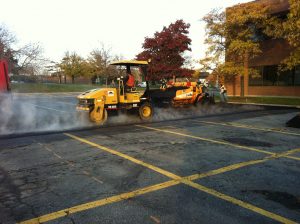What You Should Know About Repaving The Asphalt This Spring
Preparing a commercial space for the market
February 4, 2020The Good News About Post-COVID Sanitation Costs for Commercial Property Owners
June 8, 2020April is the month where many commercial landlords begin to clean up after the long winter. Often, the cold, snowy months require more than just a spring cleaning: damages due to the elements require renovations and repairs, especially the driveways, parking lots, and other surfaces on the property.
Do you really need to spend the money and time repaving your commercial property?

Repaving the Asphalt in the Spring
“One of the most frequent objections we run into from landlords is “that it is too costly to repair”, says Elizabeth Whitton of Armadale Property Management in Toronto. “Asphalt should be able to last for many years without repaving provided that landlords take the time to maintain it. However, after particularly bad winters or other changes in the ground underneath the pavement, there are some forms of damage that require you to take on more substantial repairs.”
“Alligatoring”
A telltale sign that you need to repave is “alligatoring”. This is where you see cracks in the asphalt that resemble the skin of an alligator. Normally, property owners can patch one or two cracks with rubber sealant, but if you have multiple patches of “alligatoring”, you may need to repave. A very intense winter followed by varying high-low temperatures in springtime can cause it to be widespread. A tell-tale sign that something nasty is brewing.
“In the springtime, there’s a lot of runoff water,” says Victor Abade of Toronto’s ACI Construction. “Every time you drive over asphalt, you’re moving around underlying little canals and veins of water that have seeped underneath the pavement. As they get moved around, they start to distress the base of the pavement and create alligator cracking.”
Abade explains that as temperatures rise in the spring, water starts trickling underneath into the ground beneath the pavement and then seeps into the cracks. “When the water penetrates and collects underneath the asphalt layer at night”, he says, “the water will freeze when the temperature drops and create more alligatoring. This vicious cycle continues around to the end of spring, by which point the asphalt is in dire need of repaving.”
Customer Appeal and Legal Liability
“One consideration from an aesthetic point of view”, Abade suggests, “is that having a professionally paved asphalt surface enhances the overall look of the property, which in turn compliments the businesses. It creates an inviting visit for customers, which results in repeat business”.
Another consideration is legal liability. Should a visitor to your property and suffer an injury that they claim resulted from stepping on cracks or in holes, or slips and falls in winter months due to water collecting in potholes in the asphalt, the money you save from not repaving could be eaten up in legal fees. Abade points out that “one of the questions that gets asked in legal discoveries is ‘when was the last time this property was serviced and/or maintained?’”
Avoid Cutting Corners by Using Tar
“Many commercial landlords will coat the existing asphalt with black liquid tar to make it look newly paved,” says Whitton. “However, that practice will not cover alligator cracks and will lead to environmental contamination, seeping into the surrounding ecosystem.” If caught, Whitton notes “the penalties can range from fines and even lost mortgage approvals in the future”.
By comparison, repaving asphalt is straightforward, environmentally-sound, and truly repairs rather than covers damaged paving.
Whitton notes that typically, after the spring, you want to start examining the asphalt to determine what work is needed. “I usually suggest to schedule paving projects in mid-July to mid-August because a lot of people are away on holidays and asphalt crews can get in without too much disturbance to the tenants. However, it has to be done before it gets cold again and before the asphalt installation process becomes more expensive.”
Make sure to budget for a repaving in your yearly forecasts so it doesn’t end up being an “extra” expense.
